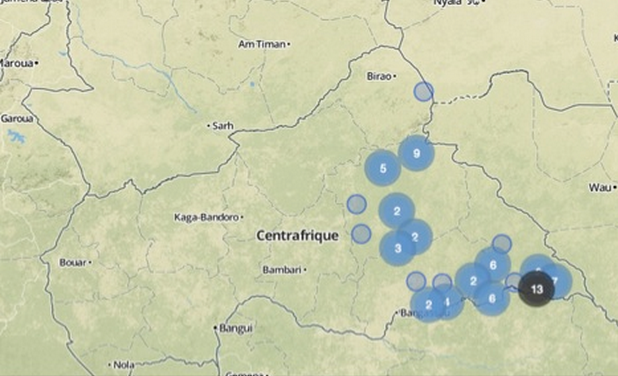The following article is reblogged from Paul Ronan and our partners at The Resolve. Since its founding in 2007, The Resolve LRA Crisis Initiative has worked to end violent atrocities perpetrated by the Lord’s Resistance Army, or LRA, and support the sustainable recovery of communities in Africa affected by LRA abuses.
—
Yesterday the UN Security Council passed a resolution authorizing a UN peacekeeping mission in the CAR (MINUSCA). If all goes to plan, the 12,000-strong force will take over from the current AU peacekeeping mission (MISCA) on September 15, when it will face the daunting task of stabilizing a nation that has been torn apart by sectarian conflict and lacks basic government institutions.
The Council resolution failed to mention that LRA attacks continue to plague eastern CAR, but the LRA does pose a significant threat to civilians living there. In particular, the LRA has conducted its worst attacks over the past 18 months in eastern CAR’s Mbomou and Haut Kotto prefectures, likely in an attempt to resupply Kony and other senior LRA officers operating there and in the neighboring Sudanese-controlled Kafia Kingi enclave. Ugandan troops authorized by the AU’s separate counter-LRA force (the AU RTF) are deployed further southeast in the CAR and can only rarely conduct sustained operations against LRA groups operating in Mbomou or Haut Kotto.

The Council resolution did call on MINUSCA to coordinate with Ugandan RTF forces and share information regarding the LRA with the RTF and NGOs, though protecting civilians in remote eastern CAR will not be an initial priorty for the peacekeepers. Even so, UN peacekeeping planners should begin looking ahead to how the mission can eventually play a role in tackling the LRA threat in CAR. Here’s three tasks they should focus on:
1.Coordinating with the AU RTF to maximize civilian protection coverage: Ugandan troops pursuing LRA forces in the CAR lack a strong civilian protection mandate and have limited access to Seleka-controlled areas of Mbomou and Haut Kotto prefectures where the LRA conducts its most violent attacks. In addition, communication between the AU RTF and MISCA has been inconsistent, leading to confusion over where troops should deploy. In coordination with Ugandan RTF troops, MINUSCA should work towards a robust civilian protection strategy that includes protection of key towns (such as Fode, Bakouma, Nzako, Bria, Ouadda, and Sam Ouandja) and the roads that connect them in LRA-affected areas of Mbomou and Haut Kotto.
2.Investigating LRA activity and sharing information with the AU RTF: The UN has a very poor understanding of LRA activity in eastern CAR, though the group is more active there than anywhere else. Large-scale LRA attacks and movements in Mbomou and Haut Kotto prefectures are rarely investigated, leaving the UN and AU blind to the extent of LRA attacks and their humanitarian impact. The lack of accurate information hampers programs to protect civilians, deliver humanitarian aid, and encourage LRA defections. As their mandate indicates, MINUSCA forces deployed to LRA-affected areas should thoroughly investigate LRA attacks and sources of external support, and share any relevant information with the AU RTF and NGOs
3.Encouraging LRA defections (the right way): Remember the “Kony surrender talks” media firestorm? Last November, Seleka representatives provided LRA officers with significant supplies in a misguided attempt to encourage their defection. Instead of doing so, the LRA officers left the area with the supplies to rendezvous with other LRA groups. As security progresses and civilian staff deploy, MINUSCA should 1.) Work with Central African authorities to ensure that all efforts to encourage LRA defections adhere to the UN’s “Standard Operating Procedures” for encouraging LRA defections, and, 2). Provide support to defections initiatives conducted by the US military and AU RTF, such as by distributing defections leaflets and radio programs and accepting LRA defectors.
Think people should hear about this?